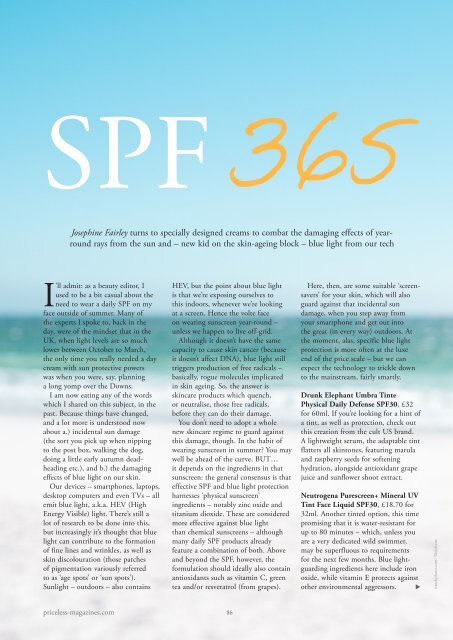Wealden Times | WT257 | October 2023 | Interiors & Bathrooms Supplement inside
The lifestyle magazine for Kent & Sussex - Inspirational Interiors, Fabulous Fashion, Delicious Dishes
The lifestyle magazine for Kent & Sussex - Inspirational Interiors, Fabulous Fashion, Delicious Dishes
You also want an ePaper? Increase the reach of your titles
YUMPU automatically turns print PDFs into web optimized ePapers that Google loves.
SPF<br />
365<br />
Josephine Fairley turns to specially designed creams to combat the damaging effects of yearround<br />
rays from the sun and – new kid on the skin-ageing block – blue light from our tech<br />
I’ll admit: as a beauty editor, I<br />
used to be a bit casual about the<br />
need to wear a daily SPF on my<br />
face outside of summer. Many of<br />
the experts I spoke to, back in the<br />
day, were of the mindset that in the<br />
UK, when light levels are so much<br />
lower between <strong>October</strong> to March,<br />
the only time you really needed a day<br />
cream with sun protective powers<br />
was when you were, say, planning<br />
a long yomp over the Downs.<br />
I am now eating any of the words<br />
which I shared on this subject, in the<br />
past. Because things have changed,<br />
and a lot more is understood now<br />
about a.) incidental sun damage<br />
(the sort you pick up when nipping<br />
to the post box, walking the dog,<br />
doing a little early autumn deadheading<br />
etc.), and b.) the damaging<br />
effects of blue light on our skin.<br />
Our devices – smartphones, laptops,<br />
desktop computers and even TVs – all<br />
emit blue light, a.k.a. HEV (High<br />
Energy Visible) light. There’s still a<br />
lot of research to be done into this,<br />
but increasingly it’s thought that blue<br />
light can contribute to the formation<br />
of fine lines and wrinkles, as well as<br />
skin discolouration (those patches<br />
of pigmentation variously referred<br />
to as ‘age spots’ or ‘sun spots’).<br />
Sunlight – outdoors – also contains<br />
HEV, but the point about blue light<br />
is that we’re exposing ourselves to<br />
this indoors, whenever we’re looking<br />
at a screen. Hence the volte face<br />
on wearing sunscreen year-round –<br />
unless we happen to live off-grid.<br />
Although it doesn’t have the same<br />
capacity to cause skin cancer (because<br />
it doesn’t affect DNA), blue light still<br />
triggers production of free radicals –<br />
basically, rogue molecules implicated<br />
in skin ageing. So, the answer is<br />
skincare products which quench,<br />
or neutralise, those free radicals,<br />
before they can do their damage.<br />
You don’t need to adopt a whole<br />
new skincare regime to guard against<br />
this damage, though. In the habit of<br />
wearing sunscreen in summer? You may<br />
well be ahead of the curve. BUT…<br />
it depends on the ingredients in that<br />
sunscreen: the general consensus is that<br />
effective SPF and blue light protection<br />
harnesses ‘physical sunscreen’<br />
ingredients – notably zinc oxide and<br />
titanium dioxide. These are considered<br />
more effective against blue light<br />
than chemical sunscreens – although<br />
many daily SPF products already<br />
feature a combination of both. Above<br />
and beyond the SPF, however, the<br />
formulation should ideally also contain<br />
antioxidants such as vitamin C, green<br />
tea and/or resveratrol (from grapes).<br />
Here, then, are some suitable ‘screensavers’<br />
for your skin, which will also<br />
guard against that incidental sun<br />
damage, when you step away from<br />
your smartphone and get out into<br />
the great (in every way) outdoors. At<br />
the moment, alas, specific blue light<br />
protection is more often at the luxe<br />
end of the price scale – but we can<br />
expect the technology to trickle down<br />
to the mainstream, fairly smartly.<br />
Drunk Elephant Umbra Tinte<br />
Physical Daily Defense SPF30, £32<br />
for 60ml. If you’re looking for a hint of<br />
a tint, as well as protection, check out<br />
this creation from the cult US brand.<br />
A lightweight serum, the adaptable tint<br />
flatters all skintones, featuring marula<br />
and raspberry seeds for softening<br />
hydration, alongside antioxidant grape<br />
juice and sunflower shoot extract.<br />
Neutrogena Purescreen+ Mineral UV<br />
Tint Face Liquid SPF30, £18.70 for<br />
32ml. Another tinted option, this time<br />
promising that it is water-resistant for<br />
up to 80 minutes – which, unless you<br />
are a very dedicated wild swimmer,<br />
may be superfluous to requirements<br />
for the next few months. Blue lightguarding<br />
ingredients here include iron<br />
oxide, while vitamin E protects against<br />
other environmental aggressors. <br />
istockphoto.com/ Ridofranz<br />
priceless-magazines.com 86


















